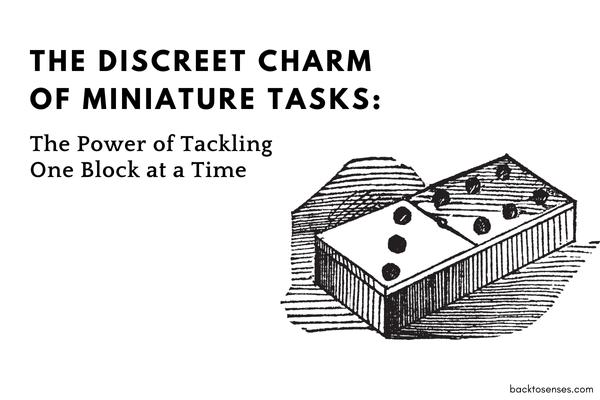In a world of sprawling visions and grand projects, there’s a seductive allure to proclaim, “Go big or go home!”.
But hold onto your hats, ladies and gentlemen, because I’m here to champion a counter-argument: “Go discrete or face defeat!”
Confused? Let me elaborate.
Discreet? How?!
In this context, “discreet” refers to breaking down a larger task or project into separate, distinct, and manageable parts.
Rather than trying to tackle a big project all at once, you divide it into smaller, individual tasks that can be completed independently.
Think bricks that can be assembled into walls, that can turn into castles.
This way, each task becomes a small, self-contained piece of the larger whole, much like a piece of a puzzle.
The use of “discreet” in this context is a play on words with “discrete”, which in mathematics and digital systems means separate or distinct.
It’s about taking control of a complex project by managing it in smaller, distinct, and easier-to-handle parts.
Imagine setting out to build the Eiffel Tower.
Do you think Gustave Eiffel just tossed the entirety of the iron on the Champ de Mars and hoped it would spontaneously arrange itself?
Au contraire!
He and his team discretely tackled it, piece by piece, rivet by rivet. The beauty of a masterpiece lies as much in its discrete parts as in its sum.
1. Chaos is the Name, Discretion is the Game
When reality has a tendency to resemble a blender — without a lid — that’s set on high, vast projects can become your Achilles’ heel. You start with zest, work tirelessly, but you’re always a “work in progress”.
Why? It’s the fallacy of the big picture without discrete building blocks.
You may be forever waiting for the perfect time to start working on what’s truly important (but seemingly less urgent) OR you can just start where you are, with what you have, and move closer to where you want to be.
Picture this: your project is the Titanic, and unforeseen circumstances are the iceberg.
If you’ve got all your eggs in one basket, you’re going down hard, Leo DiCaprio style.
However, if you’ve divided your project into several lifeboats (read: discrete tasks), you have a much higher chance of staying afloat and reaching your destination.
Creating a backlog of tasks gives you the flexibility to pivot when things go awry.
You’re prepared with an armada of tasks, ready to pull out whatever can be done. It’s your fail-safe mechanism for keeping the project inching forward, no matter what.
By dissecting projects into digestible tasks, you’re not only creating an actionable blueprint but also designing your very own chaos-proof armor.
2. The Joy of Miniature Victories
Ever baked a cake?
The sweetness of that first bite is unparalleled. Now, imagine savoring that joy every day. Breaking down your mammoth task gives you the power to do just that.
Finished a discrete task? Take a bite of that success.
Not only does this give you an immediate reward, but it fuels your drive for the bigger picture.
Suddenly, the daunting marathon becomes a series of exciting sprints!
3. The Art of Flexibility
Things rarely go to plan.
Mercury’s in retrograde, the cat spilled your coffee, and that crucial email?
Vanished.
Here’s where the magic of discrete tasks comes to the rescue.
Got just 15 minutes? Pull a tiny task from your cache.
Have a couple of hours? Go for a bigger chunk. Instead of languishing in perpetual incompletion, you’re inching forward, making tangible progress.
You become the maestro of your own orchestra, adjusting the tempo as needed.
Bit by bit by bit.
4. Unmasking the Busy Illusion
Ever been caught in the stormy sea of busyness, only to realize you’re just treading water?
Continuous work with no substantial output is the illusion of productivity.
Having a reservoir of discrete tasks reveals the reality. It draws the line between being genuinely productive and just being, well, busy.
The Discreet Revolution
Discrete tasks are more than just an organizational tool.
They’re a revolution, a paradigm shift.
A discrete approach brings clarity amidst chaos, offers tangible rewards, ensures flexibility, and dismantles the facade of faux productivity.
So the next time you’re standing at the foot of your metaphorical Eiffel Tower, remember: It’s the sum of its discrete parts that reach the sky.
Embrace the miniature, and let the discreet charm propel you towards your goals!


